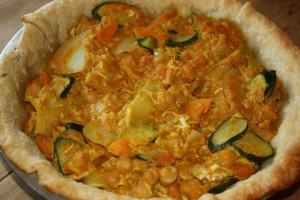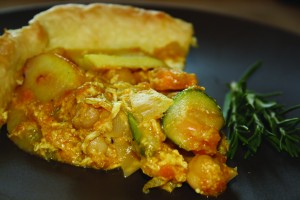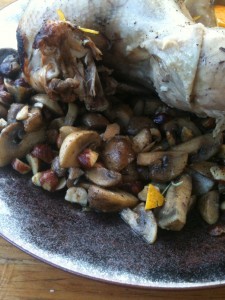Peasant Harvest Feast

When the crops were ready for harvesting, communities would come together as a community to help reap the crops and celebrate their bounty. Vegetables were plentiful and they readily became part of the feast. Similar to the American Thanksgiving, these feasts celebrated the family, the community, and the harvest.
Feasts were different for economic classes: noble’s feasts included venison, pheasant, and other wild game while the other classes enjoyed wild hare, fresh fish, and forged items like wild mushrooms, berries, and other scavenged delicacies. Recipes were created that used the harvested items and often included items that weren’t normally available, but were saved for special occasions.
The recipe below is one such recipe – vegetable pie. The filling used items that were readily found during harvest time. This particular dish may be served as a main course, an alternative to a meat option, or served as a side dish. The provided pastry crust recipe is a standard and has been used by my family for generations. Although people will often create shortcuts to any recipe and store bought pie crust and heat-and-serve soups can be used. However, the recipe I am providing has no shortcuts.
Pie Crust
2 1/2 cups all-purpose flour, plus extra for rolling
1 cup (2 sticks or 8 ounces) unsalted butter, semi soft and cut into cubes
1 tsp salt
6 to 8 tbsp ice water
Combine flour, salt, and sugar together and mix thoroughly. Add butter and crush into the flour mixture with a fork until it resembles coarse meal, with pea size pieces of butter. Add ice water a tablespoon at a time, blending until mixture just begins to clump together. Don’t add too much water as it will make the crust tough.

Place the dough on a clean surface such as a cutting board. Press down on the dough a few times to help flatten the dough between the layers of flour which will help make the crust flaky. Shape the dough mixture into two parts. Sprinkle a little flour around the mounds of dough and wrap each disk in wax paper and refrigerate at least 1 hour, and up to 2 days to cure the dough.
Remove the crust from the refrigerator. Let sit at room temperature for 5-10 minutes in order to soften enough to roll out the dough with a rolling pin on a lightly floured surface to a 12-inch circle and about 1/8 of an inch thick. Carefully place each dough segment into two 9-inch pie plates (one in each). Gently press the pie dough down so that it lines the bottom and sides of the pie plate. Pre-bake the dough at 375 degree until it is half baked.
Vegetable Pie
2 cups vegetable stock
3 large carrots, julienned
3 cloves of garlic, minced
1 medium sweet potato, peeled and julienned
1 leek, diced
4 medium red potatoes, thinly cut and then julienned
2 eggs, scrambled (for vegans use 2 tbsp of corn starch or powdered arrowroot instead)
1 can of garbanzo beans/chickpeas, drained and rinsed
4 tbsp olive oil
1/2 tsp cinnamon
1/8 tsp fresh ginger, minced (optional)
1/8 tsp powdered clove
Sauté the vegetables (carrots, garlic, leeks, sweet potatoes, and potatoes) in olive oil. When leeks are transparent, add chickpeas and 2 cups of soup or broth and continue to simmer. When carrots and potatoes are tender, slowly add eggs to thicken pie filling. If eggs are not desired, gradually add corn starch or arrowroot to thicken.
Add pie mixture to crust and continue to bake for 10 minutes until pie crust is golden brown. Let cool for 5 minutes before serving.
Cooking with Whiskey II – Carrots with Whisky Caramel Sauce
This was a surprisingly tasty complement to the Chicken with Whiskey Cream Sauce recipe. The most difficult part of the recipe is the caramel sauce.
To begin, start with 1 lb. of carrots and cut them into 1″ cubes and boil them until tender. Remove from the water and put aside.
Whiskey Caramel Sauce
1 cup brown sugar
1/3 cup whiskey
3 tbsp unsalted butter, softened
pinch of salt
1/8 tsp of powdered cinnamon, clove, and nutmeg
Heat sugar in a dry 2-quart heavy saucepan over moderate heat, undisturbed until it begins to melt. Continue to cook, stirring occasionally with a fork. Until sugar is belted into a deep golden caramel.
Remove from heat and carefully add Scotch, butter and salt. It will begin to harden and continue to cook over moderately low heat until everything is blended together.
Add the cooked carrots to the warm caramel sauce a stir lightly. Spoon the sweetened carrots onto the plate and serve.
Spice Blends from our Demonstrations
Each day, we demonstrate how to make various spice blends over an open fire. An earlier entry – http://alicethecook.com/?p=801 talks about how we do it, but doesn’t necessarily cover the recipes. Due to popular demand, below are the spices we demonstrate (and sell) at the Minnesota Renaissance Festival.
Spices change based on the tastes of individuals and family units. Some prefer savory tastes and others prefer a spicier blend. You can adjust accordingly.

Please remember that you need to use a hot, dry cast iron plate for toasting these spices.
- Gather your spices
- Toast the spices
- Grind up the spice. You can use an electronic grinder, but make sure you do not use a coffee grinder. Keep them separate so that you can enjoy both.
- Use the spices as needed
As the spices age after grinding, they diminish potency significantly over time. Most of the ingredients can be purchased through a co-op or a spice specialty store, such as Penzey’s Spices or Spice House; I’ve also had a lot of luck locating hard-to-find spices through Amazon.com.
If you to make more spices make sure you freeze your spices in an airtight bag to minimize the loss of flavor.
- Garam Masala: cumin, coriander, black pepper, cardamom, chilies, clove, cinnamon, and nutmeg
In the case of garam masala, you would toast the spices together and grind them. - Curry: sea salt, mustard seeds, turmeric, garam masala, coriander, garlic, ginger, and cumin
In the case of the curry, you would begin toasting the mustard seeds until they begin to pop. You would then add the salt, coriander, garlic, ginger, and cumin. As a note, I would strongly recommend using dried spices instead of fresh ginger and garlic as they will scorch on a hot pan. Once toasted, I would begin grinding and then add the garam masala and the turmeric after. - Ras El Hanout: cinnamon, cloves, corriader, cumin seeds, allspice, nutmeg, cardamom (use sparingly), ginger, fennugreek, fennel seeds, mustard seeds, dried Damascus rose petals, and optional chilis
Like the garam masala, these would be toasted and ground together. The rose petals will float to the top and be the last ingredient to grind.
I hope you enjoy these as much as we do!
Field Mushrooms with Hazelnuts

Another recipe from this past weekend. A delicious side dish that compliments the entrée nicely. I prefer to use this recipe with wild game.
Ingredients:
2 garlic cloves
grated rind of one lemon
6 tbsp olive oil
6 large field (button) mushrooms, diced
1/2 cup hazelnuts, coarsely chopped
2 tbsp chopped parsley
salt and ground black pepper
Crush the garlic cloves with a little salt using a mortar and pestle or on a chopping board. Place the crushed garlic in a small bowl and stir in the grated lemon rind and the olive oil. Allow the items to steep for one hour. In a large fry pan, place the mushrooms in the pan and drizzle 4 tbsp of the garlic and oil mixture on top of the mushrooms and sauté for 5-10 minutes.
Add the hazelnuts and the additional oil mixture to the pan and sauté for another 5-10 minutes or until the mushrooms are tender. Add salt and pepper and sprinkle with chopped parsley. Serve immediately with the quails or game hens. Serves 4
